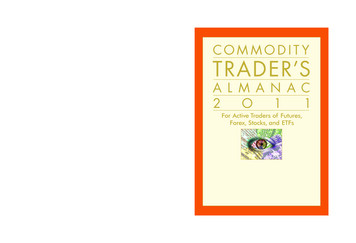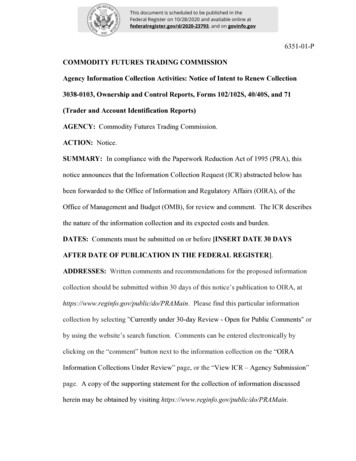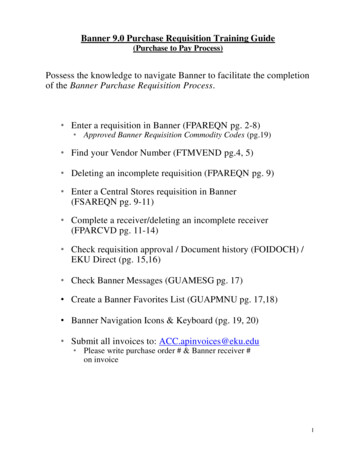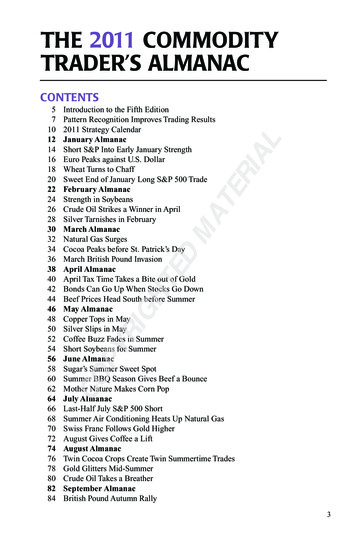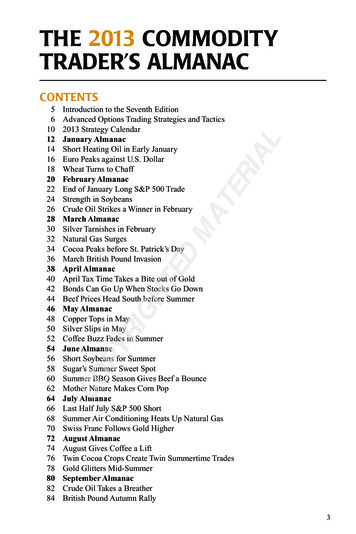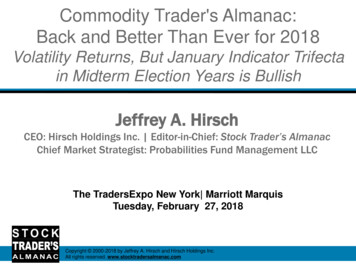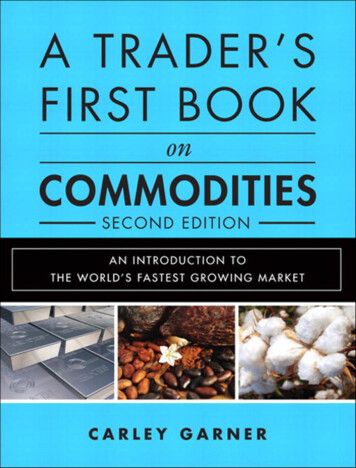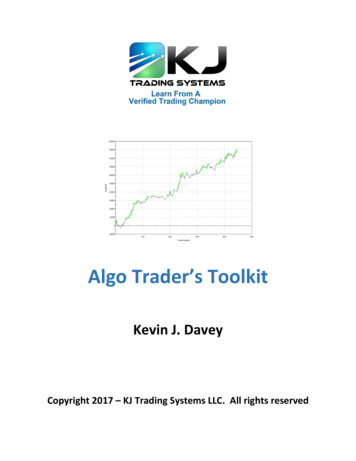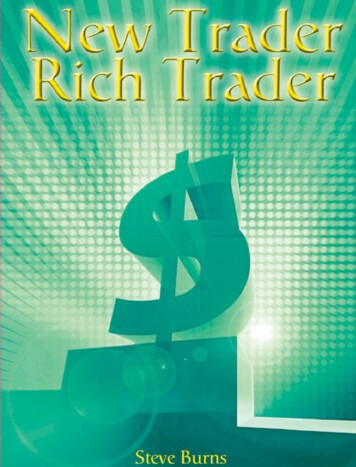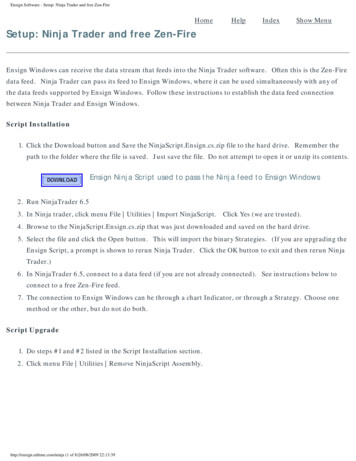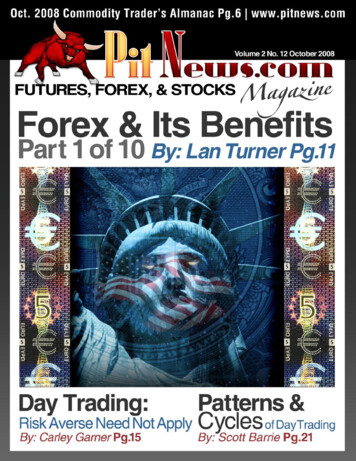
Transcription
Jan. 2008 Commodity Trader’s Almanac Pg.6 www.pitnews.comNews.comVolume 3 No. 4 January 2008FUTURES, FOREX, & STOCKSA Long-TermTrading PlanBy: Scott Barrie Pg.617 Billion Dollar Bailout:An Opportunity forPlatinumBy: Scott Barrie Pg.14Forex &Part 4 of 10ItsBenefitsBy: Lan Turner Pg. 11
Editor in Chief:Lan H. TurnerEditor:Scott Barriesbarrie@pitnews.comManaging Editor:Aaron Peckapeck@pitnews.comNational Sales Manager:Todd Hendricksthendricks@pitnews.com800.526.3019Art Director:Matthew LangenheimProduction Manager:Keegan GarrityController:Joseph ChambersWebmaster:Jacob e@pitnews.comIn this issue.05Off The Wall06A Long-Term Trading Plan11Forex & Its Benefits Part 4 of 101417 Billion Dollar Bailout:Opportunity for PlatinumBy: StewartGold and Silver are becoming interesting for apotential long, but I am putting up my Platinumchart for April here as it does have a nice pattern(in my view).By: Scott BarrieCommodities futures trading is considered a mightyrisky enterprise by most folks.By: Lan H. TurnerEmotional control makes a massive contribution to the success of a trader. The secret to tradingis not in a particular secret plan or set of strategiesthat you need to uncover.By: Scott BarriePlatinum is the rarest of all the precious metals.Often referred to as “white gold”, Platinum is 16times more rare than Gold and 100 times morerare than Silver.PitNews.com Magazine January 2009Disclaimer: The risk of loss in trading futures, options, stocks, and forex can be substantial. See Page 3 for more information.
GENERAL DISCLAIMER:THE DATA CONTAINED HEREIN IS BELIEVED TO BE RELIABLE BUT CANNOT BE GUARANTEED AS TO RELIABILITY, ACCURACY, OR COMPLETENESS; AND, AS SUCH IS SUBJECT TO CHANGE WITHOUT NOTICE. PITNEWS.COM, ITS EMPLOYEES AND CONTRACTORS WILL NOT BE RESPONSIBLE FOR ANYTHING WHICH MAY RESULTFROM RELIANCE ON THIS DATA OR THE OPINIONS EXPRESSED HEREIN. THE OPINIONS EXPRESSED HEREINARE NOT NECESSARILY THOSE OF PITNEWS.COM, ITS EMPLOYEES OR AFFILIATES.DISCLOSURE OF RISK:THE RISK OF LOSS IN TRADING CAN BE SUBSTANTIAL; THEREFORE, ONLY GENUINE RISK FUNDS SHOULD BEUSED. SPECULATIVE VEHICLES SUCH AS FUTURES, OPTIONS, AND FOREX MAY NOT BE SUITABLE INVESTMENTS FOR ALL INDIVIDUALS, AND INDIVIDUALS SHOULD CAREFULLY CONSIDER THEIR FINANCIAL CONDITION IN DECIDING WHETHER TO TRADE. OPTION TRADERS SHOULD BE AWARE THAT THE EXERCISE OF ALONG OPTION WOULD RESULT IN A FUTURES POSITION.SEASONAL DISCLAIMER:SEASONAL TENDENCIES ARE A COMPOSITE OF SOME OF THE MOST CONSISTENT COMMODITY FUTURES SEASONALS THAT HAVE OCCURRED IN THE PAST 15 YEARS. THERE ARE USUALLY UNDERLYING, FUNDAMENTALCIRCUMSTANCES THAT OCCUR ANNUALLY THAT TEND TO CAUSE THE FUTURES MARKETS TO REACT IN SIMILAR DIRECTIONAL MANNER DURING A CERTAIN CALENDAR YEAR. EVEN IF A SEASONAL TENDENCY OCCURSIN THE FUTURE, IT MAY NOT RESULT IN A PROFITABLE TRANSACTION AS FEES AND THE TIMING OF THE ENTRYAND LIQUIDATION MAY IMPACT ON THE RESULTS. NO REPRESENTATION IS BEING MADE THAT ANY ACCOUNTHAS IN THE PAST, OR WILL IN THE FUTURE, ACHIEVE PROFITS USING THESE RECOMMENDATIONS. NO REPRESENTATION IS BEING MADE THAT PRICE PATTERNS WILL RECUR IN THE FUTURE.HYPOTHETICAL PERFORMANCE:RESULTS HAVE MANY INHERENT LIMITATIONS, SOME OF WHICH ARE DESCRIBED BELOW. NO REPRESENTATION IS BEING MADE THAT ANY ACCOUNT WILL, OR IS LIKELY TO, ACHIEVE PROFITS OR LOSSES SIMILAR TOTHOSE SHOWN. IN FACT, THERE ARE FREQUENTLY SHARP DIFFERENCES BETWEEN HYPOTHETICAL PERFORMANCE RESULTS AND THE ACTUAL RESULTS SUBSEQUENTLY ACHIEVED BY ANY PARTICULAR TRADING PROGRAM. ONE OF THE LIMITATIONS OF HYPOTHETICAL PERFORMANCE RESULTS IS THAT THEY AREGENERALLY PREPARED WITH THE BENEFIT OF HINDSIGHT. IN ADDITION, HYPOTHETICAL TRADING DOES NOTINVOLVE FINANCIAL RISK, AND NO HYPOTHETICAL TRADING RECORD CAN COMPLETELY ACCOUNT FOR THEIMPACT OF FINANCIAL RISK IN ACTUAL TRADING. FOR EXAMPLE, THE ABILITY TO WITHSTAND LOSSES ORTO ADHERE TO A PARTICULAR TRADING PROGRAM, IN SPITE OF TRADING LOSSES, ARE MATERIAL POINTSWHICH CAN ALSO ADVERSELY AFFECT ACTUAL TRADING RESULTS. THERE ARE NUMEROUS OTHER FACTORS RELATED TO THE MARKETS, IN GENERAL, OR TO THE IMPLEMENTATION OF ANY SPECIFIC TRADINGPROGRAM WHICH CANNOT BE FULLY ACCOUNTED FOR IN THE PREPARATION OF HYPOTHETICAL PERFORMANCE RESULTS AND ALL OF WHICH CAN ADVERSELY AFFECT ACTUAL TRADING RESULTS.PitNews.com Magazine January 2009Disclaimer: The risk of loss in trading futures, options, stocks, and forex can be substantial. See Page 3 for more information.
Pulled off the wall From:The Pitnews.com ForumsVisit The Wall at:Forums at: http://thewall.pitnews.comThe Wall is PitNews.com’s trading forum, found on the web at http://thewall.pitnews.com or from the tablink on the front page of PitNews.com. Each month, we highlight a chart submitted by one of our users.This Month’s Off the Wall Chart comes from Stewart:Using the SSTO, Stewart looks at what Platinum.“Gold and Silver are becoming interesting for a potential long,but I am putting up my Platinum chart for April here as it doeshave a nice pattern (in my view).Signals are telling me cautiously to consider a potential long!My charts tell the story, but beware new traders with Platinum,it’s a thinly traded market at times and this April chart give littlemore than an average of 1,300 contracts traded per day over thelast 5 days!Platinum tends to help in gauging silver and gold and I haveonly traded it once in my whole trading career.”Get into the action! Start posting onThe Wall, and maybe you’ll see yourarticle or chart highlighted here in ournext issue of PitNews.com Magazine!http://thewall.pitnews.comPitNews.com Magazine January 2009Disclaimer: The risk of loss in trading futures, options, stocks, and forex can be substantial. See Page 3 for more information.
A Long-term Trading PlanBy: Scott BarrieCommodities futures trading is considered amighty risky enterprise by most folks. Andthey are right if you examine the way mosttraders trade. Market lore holds that 80%(or even 90%) of futures traders lose money.This fact seems impossible, given the plethora of bookswritten on the subject, as well as the various “courses”,seminars, software, and other materials available to educate one about futures. Yet, this remains a fairly static fact,which during my time as an analyst for a brokerage firm Icould confirm as being true.game, meaning that for every dollar made, there is a dollar lostas each “long” contract has a corresponding “short” contract andonly one side can win. Multiple “longs” and “shorts” may movein and out of the market, making and losing money, but at theend of each day the dollars won and lost on contracts are totaledand allocated. Typically, over the long run, 80% of the loses goto pay 20% of the market participants.The 80/20 RuleIn the futures market, the small collective who makes moneywhile the bulk do not is known as the 80/20 rule. This is aNaysayers will point out that commission rates have dropped variation of Pareto Principle, which states that roughly 80% ofsubstantially (a decade ago, I remember “discount” accounts the effects come from 20% of the causes. In business, it is “20%being in the 20 to 30 a side range with no broker support), of your customers create 80% of your income.” This 80/20 ruleaccess to information has increased thanks to affordable PC’s of thumb is commonly stated throughout business and is theas well as the internet. Surely all of these factors have changed basis for the Six Sigma approach, as well as the Small Businesscaused more traders to make money? Sadly, the answer is prob- Associations figures which state that only 1 of 5 new restaurantsably NO!are profitable after 5 years.The futures, as well as the options markets are a “zero sum”Honestly, I have never seen the landmark study – which sup-
posedly exists - that shows that 80% of futures/options traderslose money. However I believe, from personal experience rangingfrom the trading floor, risk management, as well as brokerage thatthe Pareto Principle is fairly close to truth (note: I also believein Santa Clause, the Easter Bunny, the “single shooter” or “magicbullet”, as well as Loch Ness, UFO’s and other fringe ideas.) Ibelieve that the reason may well be that as traders, we all studythe same materials, apply the same principles, which by logicalassociation will lead us all to the same result – failure!Efficient Market?The first principle of technical analysis is that price representsall that is known. Price represents all known supply and demandconsiderations, after all price is the arbitrator between buyers andsellers. Price represents the point where a seller is willing to partwith his/her goods as well as the point where a buyer is willing topay for such goods. If this is true, and price does reflect all knowninformation, then nobody should be able to beat the market!The first principle of technical analysisis that price represents all that isknown.However, our industry is full of people who beat the market.Floor traders do it as I know a few who live in very nice houses,as well as the “rock stars” of Speculation like George Soros (of “Ibroke the Bank of England fame”), John Henry (of “I own theBoston Red Soxs” fame), as well as Tom Baldwin (of “I own severalblocks surrounding the CBOT as well as had a floor hand signalnamed after me” fame), and Steve Fossett (of “I made enoughmoney in options to balloon around the world” fame, god rest hissoul, he was a nice guy I actually met him once and he was niceunder unpleasant circumstances) just to name a few.Of course, in a large, random system a few people will alwaysmake money just by chance. But, some of the accomplishments(earnings and profits) of these individuals can not be explained bysheer randomness.What they all have in common is that they found their ownway, outside the beaten path. After all if “common knowledge”made great traders, the most well read of us all would be millionaires multiple times over. Of course, knowledge is useful, butknowledge is subjective and no one has the answer for you, butyou! However, I have a suggestion that may prove fruitful fora few traders who are patient, and more interested in makinga decent return out of the market, while maintaining risk at anacceptable level which should ensure they will stay in the “game.”Risk management does come at the expense of making an overnight fortune, but Risk Management also ensures that one will beable to put on another trade.PitNews.com Magazine January 2009Disclaimer: The risk of loss in trading futures, options, stocks, and forex can be substantial. See Page 3 for more information.
Managing RiskThe older I get and the more I watch the markets, themore I like options. Option strategies allow a trader to set-uppositions where risk is defined, and the likely outcome has ahigh probability – at the time of trade initiation – of beingsuccessful.Futures, by their very nature, have unlimited risk ifyou don’t believe me, read your account paper work and thebeginning of this magazine where it state “it is possible to loseMORE than your initial investment.” Some option strategiesdo also – such as “naked” or unprotected written (sold) options.In the futures market, stop losses are used to manage risk, asorders are placed to exit a position at a specific price. However,market conditions vary and many markets can move througha stop loss order like a hot knife through butter, leaving thetrader with a loss much greater than he/she expected.The only way to completely limit risk is by using options!However, risk reduction comes at the expense of giving upreward potential. An option buyer gives up the premiumpaid in return for unlimited reward potential. However, mostoptions – like traders – end their lives being either worthless or beingworth less than when they started. However, options can be eitherbought or sold, and as such traders can set-up positions which have asolid probability of being profitable to a finite extent, and at the sametime risk can be managed down to the exact penny. One example ofthis is the “Bull Call Spread.”An option buyer gives up the premiumpaid in return for unlimited rewardpotential.This strategy is used when you believe a market will go up, as BullPut (Credit) Spreads are a low risk, limited reward strategy. Bull PutSpreads are generally “Out Of The Money” trades. A Bull CreditSpread can also be put on at-, or in- the- money, which essentiallyincreases both the risk and the potential profit, depending upon howbullish you are on the market.PitNews.com Magazine January 2009Disclaimer: The risk of loss in trading futures, options, stocks, and forex can be substantial. See Page 3 for more information.
This strategy is basically a bet that prices will stay or end upabove the short Put (higher strike price) option and not end upbelow the long Put (lower strike price) option. In other words,this strategy is often used to bet that prices will not go somewhere, as opposed to betting that they will go somewhere.The difference in betting where prices will be and where theywon’t may well be the key. Small traders, those of us with limitedmeans who want to practice good money management and notrisk more 10% of their account balance (that’s 500 for a 5,000account and 1,000 for a 10,000 account) on any one trade, oreven better 5% or less like the professionals do, should becomefamiliar with this strategy. Though the rewards are limited(the premium received less the premium paid, or short optionpremium – long option premium), the risk is limited as well.Traders, who are paying attention can set-up such strategies toMay High Grade Copper FuturesPrices and Changes in Cents/LB and 16.91maximize their potential for profits, as well as limit their risks,ensuring that no unwanted surprises will occur.A Quick SampleBased on the research from the 2009 Commodity Trader’sAnnual (available at www.COMMODITYALMANAC.com)traders may wish to take note that May High Grade Copperfutures (HG) have increased in price from the end of December%DEC-APR BREAKCENTS/LB-6.45#Up%DEC-APR RALLY%through to the end of April in 15 of the last 20 years, includingeach of the last 5 years when the “Real Estate Bubble” has beenin full force as well as its bust in 2007.This position also takes advantage of the over-sold nature ofthe copper market as well as natural support, both from an oldtrading range as well as a Fibonacci Retracement level.This long-term strategy also has the advantage of being offthe radar of most traders. Most futures traders – shall we say thePitNews.com Magazine January 2009Disclaimer: The risk of loss in trading futures, options, stocks, and forex can be substantial. See Page 3 for more information.
“80%” – look for short-term moves. But, looking longer-termallows traders to position themselves for major moves, and whencombined option strategies like the BULL PUT SPREAD– which has limited risk – allows the speculator to move abovethe fray and noise.Given that Copper is a very macro economically sensitivecommodity, especially towards real estate, a long Copper position looks fool hardy at present but of course, you can’t tell tillyou bet . A conservative trader may wish to look at establishingthe following BULL PUT SPREAD Sell May 150 Put Buy May 140 Put HG2009K @ 156.45 establish for a net credit of 5.00 cents/lb ( 1,250 beforecommissions and fees) or betterThe maximum risk on this position is -5.00 cents/lb (- 1,250before commissions and fees) which is equal to the rewardpotential. However, traders should note that this position isprofitable (at 5.00 cents/lb) above 150, giving the position 6.45cents/lb “wiggle room” before the maximum profitability beginsto deteriorate. The “break even” on the position is 145 beforecommissions and fees, and the maximum loss will occur below140.Though the end of April (04/27/09) is a long ways away,traders should take comfort in the fact that the proposed financial rescue plan should be in force by then, pumping money intobuilding and the economy two factors which should benefitCopper.Using this strategy, traders are looking for an equal return torisk, with the added edge that if prices stay flat – unchanged – ordo not decline much, this position will be profitable.This position also takes advantage of the over-sold nature ofthe copper market as well as natural support, both from an oldtrading range as well as a Fibonacci Retracement level.CONCLUSIONBy going against conventional wisdom, traders may be betteroff. Usually when one runs with the herd, the greatest risk theyhave is being trampled. Conventional wisdom in the futuresmarkets is most likely wrong! After all, if it were correct, thenmore people would make money.The trick may be to practice solid money management andrisk control, as well as trade in a time frame which is unpopularso one does not have as much competition.PitNews.com Magazine January 2009Disclaimer: The risk of loss in trading futures, options, stocks, and forex can be substantial. See Page 3 for more information.10
Forex CadetPilotTrainingPart 4 of 10“Forex Flight Center”By: Lan h. TurnerPilots are not only skilful intheir ability to competentlytake off, fly and land massive pieces of machinery, butthey also have a considerableamount of psychological pressure withthe need for a high level of emotionalcontrol. To take hundreds of people’slives into their hands, both within theplane and those below, takes guts andconfidence within their own ability andthe plane itself.Emotional control makes a massive contribution to the success of a trader. The secretto trading is not in a particular secret planor set of strategies that you need to uncover,instead it is the ability to always remainemotionally in control; detaching from anyexternal influences that will be temptingyou to take actions which are outside of yourTrading Plan rules.Emotional controlmakes a massive contribution to the success ofa trader.PitNews.com Magazine January 2009A pilot will be faced with many differentexternal conditions; high winds, rain, fog,clouds, birds and even other aircraft. Thesesometimes arrive with no warning. Tradersexperience the very same onset of conditions, and the point I am trying to make is;it is their reaction to these conditions thatdetermines their level of continued success.The financial markets are based uponemotion and are the pure reflection of eachindividual market participant’s perception,and therefore reaction to what they see andhear. It also goes much deeper than theirperception to events. A traders success canalso be affected by their ‘money habits’; thesehabits are acquired through the conditioningof their childhood.If the child is brought up in an environment where the household spends what theyearn, especially on unnecessary items (theyacquired little or no assets); or spends morethan they earn (large household debt), thenthis person will most certainly have the same11Disclaimer: The risk of loss in trading futures, options, stocks, and forex can be substantial. See Page 3 for more information.
money handling skills into their adult life. Unless they make aconscious decision to gain better money skills, because regardless of how much they make, it will dissipate the same way.You know, when I first heard the concept of ‘TradingPsychology’ and how significant it was to being successful in themarkets, I first thought to myself . “well I have good emotionallevel headed and don’t get flustered too easily”. It was until muchfurther down the track did I realize that this wasn’t enough – itwent so much deeper than that.My money habits, my money handling skills were really bad.Anytime money came into my hands I had to spend it. Withthe financial markets being highly liquid I could access my cashalmost immediately, and spend I did.It is really hard to see what our habits are until we make theconscious decision to ‘see’ them.Otherwise we are simply operating from a preconditionedstate – our habitual state. And all this seems very ‘normal’ to us,and often we think it is how everyone else functions too.If you want to know how you ‘think around money’ look atwhat your current results in your life are.It is really hard to see what our habitsare until we make the consciousdecision to ‘see’ them.tioning. Most of our reactions to external events were copied andlearned off of our parents; the way we react to conflict, to busytraffic jams, to unforeseen events, to losing money, to makinglarge sums of money.Do you get anxious when faced with adversity, or over elatedwhen faced with euphoric situations?Trading the financial markets entails emotional ups and downslike a flight on a stunt plane– looped de loops, quick turns, highand low altitudes, followed by steep dives. Watching profits comeand then go can make any person feel sick to their stomach, andif you haven’t been following, or have confidence within, yourtrading plan, then these feelings will be intensified and can swingfrom one emotion to another very quickly and without warning.Trading the financial markets entailsemotional ups and downs like a flighton a stunt planeOur emotions stem from our perception of external events.Most people live at the mercy of their emotions – when theyWhat sort of annual income are you on? Do you have many orany Assets? What is your Net Worth? - add up your Assets andthen deduct all of your Liabilities to find out your Net Worth.Are you forever chasing your tail with bills? Are you Asset richbut Cash poor?The answers and reflection upon these questions will allowyou valuable insight into what your thinking has been up, untilthis point, around money – do you respect money?The good thing is that you can change it.Some people have had the right upbringing in so far that theyreceived the right money handling skills and emotional controlthat allows money to flow into their lives and is retained withinthe right forms. Their money is spent mostly on appreciableassets than depreciable assets.If this is their ‘normal’, these people do find it hard to ‘see’ howemotional control could be one of the most important things toobtain and therefore succeed in trading. They already have it. Itis only when we need to change our habits, do we realize howhard they can be to change.Emotional control spans across the traders’ ability to researchthe necessary skills and strategies required to create and retainwealth – not just being able to enter and exit the market ina timely manner. Profits need to be handled and reinvestedcorrectly.Our emotional control also stems from our childhood condiPitNews.com Magazine January 2009Disclaimer: The risk of loss in trading futures, options, stocks, and forex can be substantial. See Page 3 for more information.12
see or hear something they automatically react from a habitualstate rather than with actions that are the most advantageous forthemselves and any other party concerned.Their decisions are based emotionally rather than logically orupon a system. Systems, when followed religiously, can give fairlypredictable results. But if the trader deviates from the systemsvariables the prediction of the outcomes becomes obsolete.If a person is unaware that they are reacting emotionally, ratherthan an approach that is nonemotional and mechanical with everypart of their system followed step-by-step, they will be wonderingwhy they are not finding consistent success.The emotions that drive the market are fear, greed, ego and hope.Traders will be experiencing one or more of these simultaneouslyor at rapidly changing time frames. It is ok to feel these emotions,what is not ok is reacting to them in ways that are outside of yourtrading plan guidelines. If your trading plan tells you to close outyour entire position, even though you have just made a massiveprofit your ego is most likely enticing you to hang in there longerto make more profits. Not only that, but this ego is also fantasizingabout the new convertible it can see itself in. “Just a little longerin this trade and I can afford a deposit on that new luxury car”.The weakness displayed in the market, which was why yoursystem was giving sell signals, suddenly becomes very apparent asthe market plummets and goes against you, eating up all profits.Feelings of anxiety and fear replace those happy feelings of elation.If you continue to hang on to the position hoping it will go back up,you have moved through another of the emotional states again.It is amazing how well our mind and emotions can trick usinto thinking that ‘this time it is different’.And often becomes much worse when the outcome is fruitful by chance. This causes the trader to experience delusions oftheir ability, thinking that they either have a ‘natural’ ability or‘intuition’ around the market – but sooner or later will become aslap in the face.I believe that intuition for the markets movement is createdwhen the trader has taken the time to research, study and practice their system over various market conditions so that it hasbecome internalized.Regardless of our background conditioning anyone canbecome successful, you just need to have the passion, desire anddrive to succeed. If you have a good understanding and vision ofwhat the Forex market can offer, then you will do what it takes– the lifestyle it can bring is certainly worth it.Don’t try to take short cuts in your learning either – as youwill need to eventually go back over what you missed and willinvariably lengthen the total learning process. This is enhancedby our psychological makeup whether we naturally try to ‘skip’over new material or sometimes we assume that we ‘know italready’. However, I believe we don’t really know something at adeep level until we are successful at itThere are a number of books written on the psychologyof trading, I would suggest you source and read these books.One brilliant one is called ‘The Disciplined Trader’, by MarkDouglas.PitNews.com Magazine January 2009Disclaimer: The risk of loss in trading futures, options, stocks, and forex can be substantial. See Page 3 for more information.13
17 BILLION DOLLARBAIL-OUT:OPPORTUNITY FOR PLATINUMBy Scott BarrieSpanish Conquistadors discovered platinum approximately 400 years ago whenthey were panning for Goldin Choco region of what isknown today as Colombia. Considereda nuisance as Platinum interfered withgold panning, Platinum was discardedas worthless until a Swedish Assayer,Scheffer, in 1751 successfully melted andworked the substance the Conquistadorscould not “melt by fire or by any of theSpanish arts”. By 1780, French glassworkers were using Platinum to makecrucibles for glass production since Platinum did not melt at the extreme heat usedto make glass. Platinum’s resistance toheat, corrosion, and strength made it animportant industrial metal.Platinum is the rarest ofall the precious metals.Platinum is the rarest of all the preciousmetals. Often referred to as “white gold”,Platinum is 16 times more rare than Goldand 100 times more rare than Silver. Toput the supply of Platinum in perspective,more than twice as much steel is pouredeach day in the United States, thanPlatinum is produced in the world eachyear!The industrial and materialistic usesof Platinum have grown over the years.In the 19th century when jewelers wereable to melt Platinum, “white gold” beganto replace Silver in jewelry. The lustrouswhite color of Platinum better accentuatesdiamonds and the bands can be muchsmaller as it is over 100 times strongerthan Silver. Jewelry demand for PlatinumPitNews.com Magazine January 2009Disclaimer: The risk of loss in trading futures, options, stocks, and forex can be substantial. See Page 5 for more information.14
accounts for roughly 21% of total usage. The bulk ofdemand comes from industrial applications, making thismetals more Industrial than Precious on a usage basis.The usages of Platinum in the modern world arefar reaching, it is estimated that 20% of all the goodsmanufactured today either contain Platinum or wereproduced using Platinum containing equipment. Howeverthe largest industrial usage of Platinum is from theAutomotive Industry. Because of Platinum’s catalyticqualities, it is used in catalytic converters by the automotiveindustry. Catalytic converters are used to take toxicgasses produced using unleaded gasoline and turn theminto carbon dioxide and water. Demand for Platinum fromthe automotive industry accounts for roughly 80% of theuse of Platinum each year.Given the current recession, it is no wonder that Platinumprices have fallen, after all the demand component of thismetal is mainly Industrial. But recent Government actionsmay well push this metal higher! Not to mention thatboth historically as well as technically, Platinum appearsto be rea
Jan. 2008 Commodity Trader’s Almanac Pg.6 www.pitnews.com Trading Plan By: Scott Barrie Pg.6 A Long-Term FUTURES, FOREX, & STOCKS News.cVolumeo 3 No. 4 mJanuary 2008 17 Billion Dollar Bailout: An Opportunity for Platinum By: Scott Barrie Pg.14
